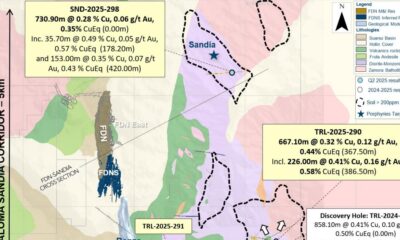Analys
One year after USD -37.63/bl


It is exactly one year since WTI crashed to USD -37.63/bl. Yes, it was probably trading games involved. Yes, it was highly specific to storage and pipeline constraints at the pricing point of WTI in Cushing Oklahoma as Brent crude only fell to USD 19.33/bl. Yes, it was a price war between Russia and Saudi Arabia which broke out after the 6 March meeting. Yes, it was Covid-19 lock-downs which killed demand. But what really stands out looking back was that you don’t steal from the King. You don’t steal from OPEC. You don’t steal market shares from the world’ lowest cost producers. Try that again and you’ll get punished again.

The price war between Russia and Saudi Arabia which broke out after the 6 March meeting last year looked like an ill considered tantrum from a hot tempered Muhammed bin Salman in Saudi Arabia lashing out against Russia which did not want to play the ”hold back production, loose market share, get higher prices” game any more. And maybe such a tantrum was really what happen. Who knows.
But the underlying fundamentals story here was that US liquids production was growing like crazy. From Sep 2016 to Jan 2020 it grew by 6.6 m bl/d. And Russia was sick of holding back production forever while seeing US taking more and more market share. The only reason for why this could go on as long as it did was because there was an almost comparable large decline in supply from the key OPEC producers being Venezuela, Iran and Libya which lost 4.5 m bl/d from mid-2017 to mid-2020. Thus yielding room for the incredible US production growth.
It was like the business strategy of US shale oil players was: ”Let’s steel market share from the lowest cost producers in the world being OPEC/OPEC+. Fundamentally that is a no-go strategy to start. Though it can go on for a little while before it falls apart. And it did go on for a little while but largely because of the very large decline from Venezuela, Libya and Iran. But looking back it is obvious that it had to end.
OPEC knows very well that the oil price is all about controlling supply. There is an infinite amount of oil under ground. Make sure it is not too much above ground and you’ll get rich. I.e. control your capex spending. US shale oil players obviously have been nowhere near thinking along such lines.
Looking forward is not all such a great picture if we base it on 1) The ongoing return of production from Iran and Libya. I.e. the reversal of the losses within OPEC from mid-2017 which enabled the US shale oil boom to go on as long as it did and 2) The projected non-OPEC production growth from the US EIA in its March STEO pointing to a very strong rebound in both US shale oil and total non-OPEC production towards the end of 2022.
The key message from 20 April 2020 is: Do not steal from the King. Do not try to steal market shares from the worlds lowest cost producers (it is stupid). If you do you will get punished again. In a world where oil demand is growing at around 1% over the coming years you should not lay plans for growing your production at 2% or 5% or 10% per year. Because if you do it fundamentally means that you must steel market share from someone. It for sure won’t be the lowest cost producers.
The end-game though could be that there is only one way to tame the production from non-OPEC and that is a lower price.
Brent and WTI crude prices and the crazy WTI crash to USD -37.63/bl. The recovery since then is all due to deep cuts in production by OPEC+ and still is. If OPEC+ hadn’t still been holding back significant volumes then we would have had no more than USD 30-40/bl today.
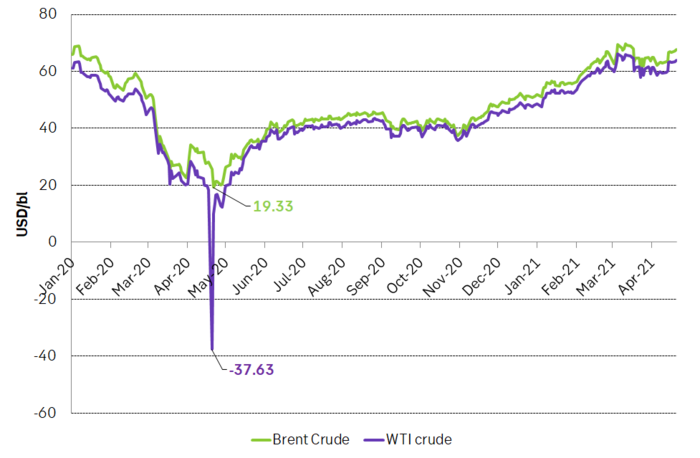
Crazy US hydrocarbon liquids growth. From a low in Sep-2016 it grew by 6.6 m bl/d before the collapse in Q1-2020. According to the EIA’s STEO from March it is set to revive and reach the same gain at the end of 2022 though the EIA STEO from April has modified that a bit lower again.
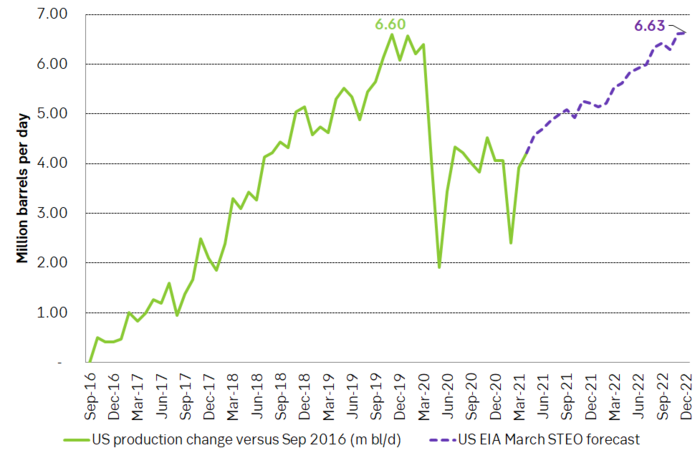
The same chart for changes in total non-OPEC production since Sep-2016 gives much the same picture. What we see is that it is not only US production which increased but also other non-OPEC producers lifted increased production in this period. But mostly it is US.
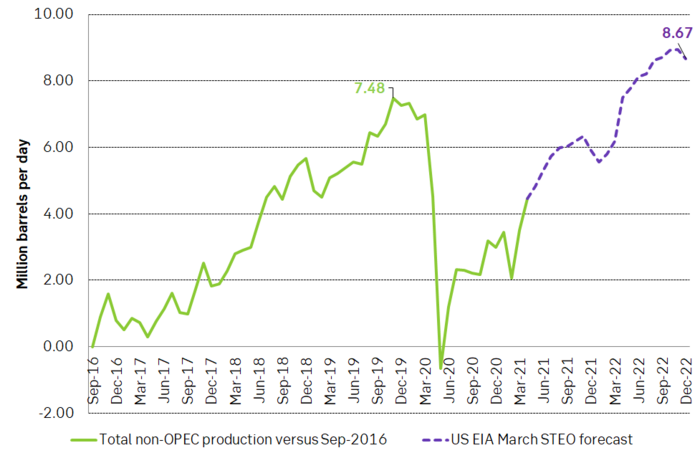
And the maga-growth in non-OPEC production did of course take their market share from OPEC. Massive decline in production by three OPEC members Iran, Venezuela and Iran. Libya has now kicked back with more to come and Iran is just about to move into the market again as signals from the ongoing Vienna talks on the revival of JCPOA (Iran nuclear deal) are positive with all sides at the table wanting the same thing. Saudi Arabia, Israel and the Iranian Revolutionary Guard may not want success but they are not sitting at the negotiation table in Vienna. A strong rebound in non-OPEC production as envisioned by the EIA March STEO forecast will be outright impossible with a production revival from these three countries.
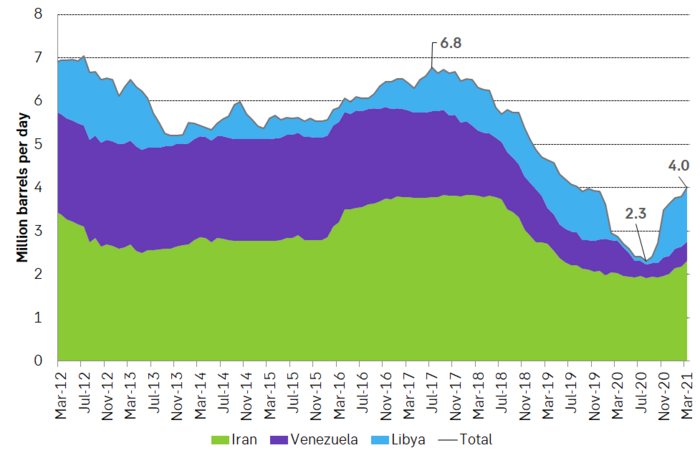
Analys
OPEC+ in a process of retaking market share

Oil prices are likely to fall for a fourth straight year as OPEC+ unwinds cuts and retakes market share. We expect Brent crude to average USD 55/b in Q4/25 before OPEC+ steps in to stabilise the market into 2026. Surplus, stock building, oil prices are under pressure with OPEC+ calling the shots as to how rough it wants to play it. We see natural gas prices following parity with oil (except for seasonality) until LNG surplus arrives in late 2026/early 2027.

Oil market: Q4/25 and 2026 will be all about how OPEC+ chooses to play it
OPEC+ is in a process of unwinding voluntary cuts by a sub-group of the members and taking back market share. But the process looks set to be different from 2014-16, as the group doesn’t look likely to blindly lift production to take back market share. The group has stated very explicitly that it can just as well cut production as increase it ahead. While the oil price is unlikely to drop as violently and lasting as in 2014-16, it will likely fall further before the group steps in with fresh cuts to stabilise the price. We expect Brent to fall to USD 55/b in Q4/25 before the group steps in with fresh cuts at the end of the year.

Natural gas market: Winter risk ahead, yet LNG balance to loosen from 2026
The global gas market entered 2025 in a fragile state of balance. European reliance on LNG remains high, with Russian pipeline flows limited to Turkey and Russian LNG constrained by sanctions. Planned NCS maintenance in late summer could trim exports by up to 1.3 TWh/day, pressuring EU storage ahead of winter. Meanwhile, NE Asia accounts for more than 50% of global LNG demand, with China alone nearing a 20% share (~80 mt in 2024). US shale gas production has likely peaked after reaching 104.8 bcf/d, even as LNG export capacity expands rapidly, tightening the US balance. Global supply additions are limited until late 2026, when major US, Qatari and Canadian projects are due to start up. Until then, we expect TTF to average EUR 38/MWh through 2025, before easing as the new supply wave likely arrives in late 2026 and then in 2027.
Analys
Manufacturing PMIs ticking higher lends support to both copper and oil

Price action contained withing USD 2/b last week. Likely muted today as well with US closed. The Brent November contract is the new front-month contract as of today. It traded in a range of USD 66.37-68.49/b and closed the week up a mere 0.4% at USD 67.48/b. US oil inventory data didn’t make much of an impact on the Brent price last week as it is totally normal for US crude stocks to decline 2.4 mb/d this time of year as data showed. This morning Brent is up a meager 0.5% to USD 67.8/b. It is US Labor day today with US markets closed. Today’s price action is likely going to be muted due to that.

Improving manufacturing readings. China’s manufacturing PMI for August came in at 49.4 versus 49.3 for July. A marginal improvement. The total PMI index ticked up to 50.5 from 50.2 with non-manufacturing also helping it higher. The HCOB Eurozone manufacturing PMI was a disastrous 45.1 last December, but has since then been on a one-way street upwards to its current 50.5 for August. The S&P US manufacturing index jumped to 53.3 in August which was the highest since 2022 (US ISM manufacturing tomorrow). India manufacturing PMI rose further and to 59.3 for August which is the highest since at least 2022.
Are we in for global manufacturing expansion? Would help to explain copper at 10k and resilient oil. JPMorgan global manufacturing index for August is due tomorrow. It was 49.7 in July and has been below the 50-line since February. Looking at the above it looks like a good chance for moving into positive territory for global manufacturing. A copper price of USD 9935/ton, sniffing at the 10k line could be a reflection of that. An oil price holding up fairly well at close to USD 68/b despite the fact that oil balances for Q4-25 and 2026 looks bloated could be another reflection that global manufacturing may be accelerating.
US manufacturing PMI by S&P rose to 53.3 in August. It was published on 21 August, so not at all newly released. But the US ISM manufacturing PMI is due tomorrow and has the potential to follow suite with a strong manufacturing reading.
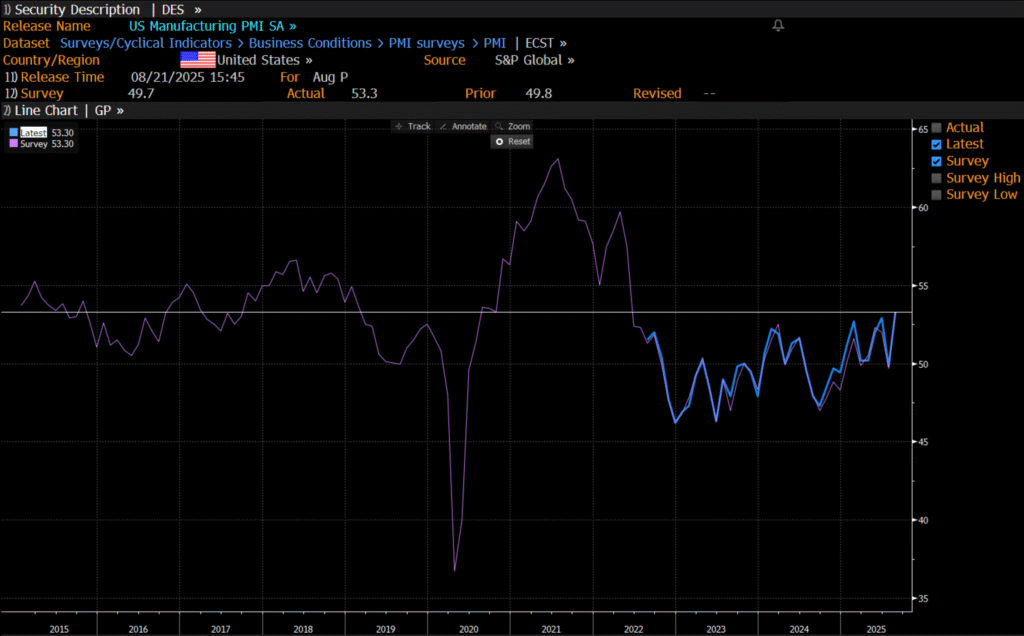
Analys
Crude stocks fall again – diesel tightness persists

U.S. commercial crude inventories posted another draw last week, falling by 2.4 million barrels to 418.3 million barrels, according to the latest DOE report. Inventories are now 6% below the five-year seasonal average, underlining a persistently tight supply picture as we move into the post-peak demand season.

While the draw was smaller than last week’s 6 million barrel decline, the trend remains consistent with seasonal patterns. Current inventories are still well below the 2015–2022 average of around 449 million barrels.
Gasoline inventories dropped by 1.2 million barrels and are now close to the five-year average. The breakdown showed a modest increase in finished gasoline offset by a decline in blending components – hinting at steady end-user demand.
Diesel inventories saw yet another sharp move, falling by 1.8 million barrels. Stocks are now 15% below the five-year average, pointing to sustained tightness in middle distillates. In fact, diesel remains the most undersupplied segment, with current inventory levels at the very low end of the historical range (see page 3 attached).
Total commercial petroleum inventories – including crude and products but excluding the SPR – fell by 4.4 million barrels on the week, bringing total inventories to approximately 1,259 million barrels. Despite rising refinery utilization at 94.6%, the broader inventory complex remains structurally tight.
On the demand side, the DOE’s ‘products supplied’ metric – a proxy for implied consumption – stayed strong. Total product demand averaged 21.2 million barrels per day over the last four weeks, up 2.5% YoY. Diesel and jet fuel were the standouts, up 7.7% and 1.7%, respectively, while gasoline demand softened slightly, down 1.1% YoY. The figures reflect a still-solid late-summer demand environment, particularly in industrial and freight-related sectors.
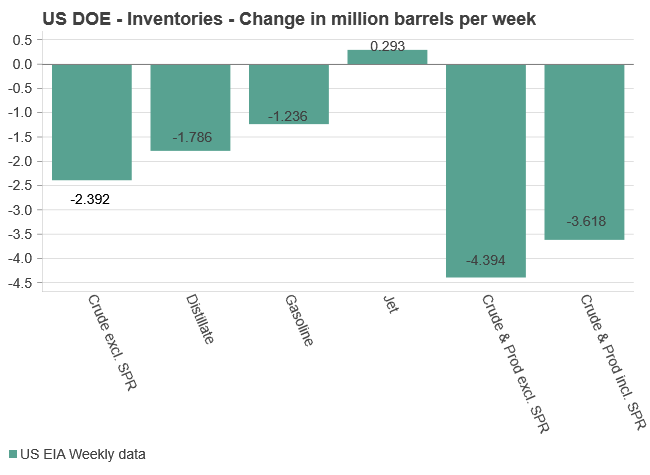
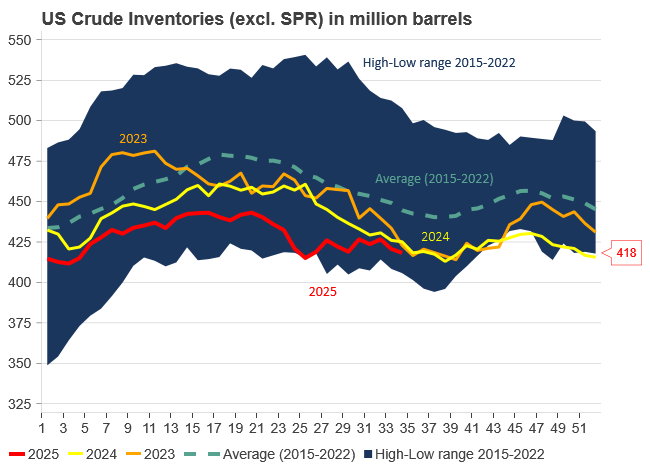
-
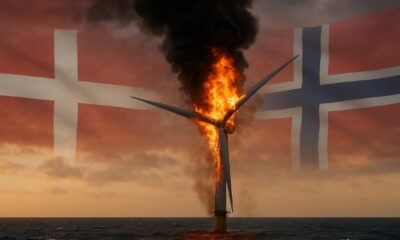
 Nyheter4 veckor sedan
Nyheter4 veckor sedanOmgående mångmiljardfiasko för Equinors satsning på Ørsted och vindkraft
-

 Nyheter2 veckor sedan
Nyheter2 veckor sedanMeta bygger ett AI-datacenter på 5 GW och 2,25 GW gaskraftverk
-

 Nyheter4 veckor sedan
Nyheter4 veckor sedanGuld stiger till över 3500 USD på osäkerhet i världen
-

 Analys4 veckor sedan
Analys4 veckor sedanWhat OPEC+ is doing, what it is saying and what we are hearing
-

 Nyheter2 veckor sedan
Nyheter2 veckor sedanAker BP gör ett av Norges största oljefynd på ett decennium, stärker resurserna i Yggdrasilområdet
-

 Nyheter4 veckor sedan
Nyheter4 veckor sedanLyten, tillverkare av litium-svavelbatterier, tar över Northvolts tillgångar i Sverige och Tyskland
-

 Analys2 veckor sedan
Analys2 veckor sedanBrent sideways on sanctions and peace talks
-

 Nyheter2 veckor sedan
Nyheter2 veckor sedanEtt samtal om koppar, kaffe och spannmål




